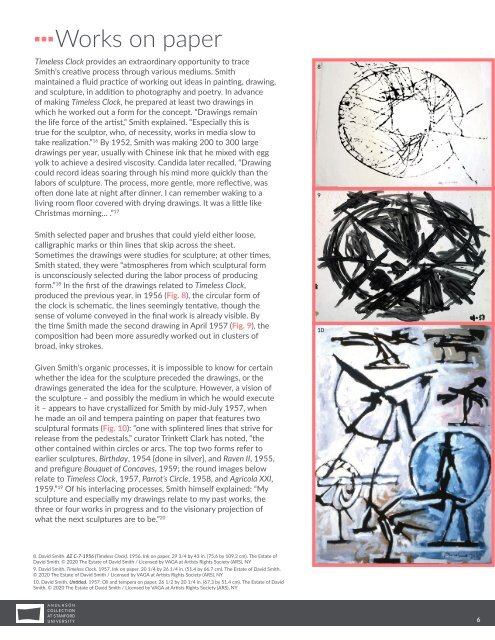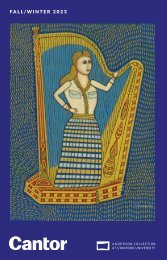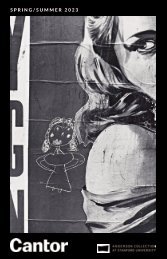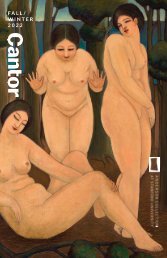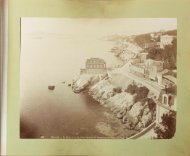Learning Guide | David Smith's Timeless Clock
In Timeless Clock, Smith welded together silver rods of varying lengths and widths onto broken axes that transgress the rough perimeter of an open circle. The result is a complex arrangement of shard-like projections into space – like an exploded clock, perhaps, that can no longer tell time. Smith possessed a deep knowledge of the physical properties of his materials. His reasons for choosing silver, a relatively precious metal commonly associated with decoration, to make Timeless Clock are unknown, though Smith’s younger daughter, Candida, has said that her father “loved the living glow” of silver. Jennifer Field, PhD Executive Director of the David Smith Estate
In Timeless Clock, Smith welded together silver rods of varying lengths and widths onto broken axes that transgress the rough perimeter of an open circle. The result is a complex arrangement of shard-like projections into space – like an exploded clock, perhaps, that can no longer tell time. Smith possessed a deep knowledge of the physical properties of his materials. His reasons for choosing silver, a relatively precious metal commonly associated with decoration, to make Timeless Clock are unknown, though Smith’s younger daughter, Candida, has said that her father “loved the living glow” of silver.
Jennifer Field, PhD
Executive Director of the David Smith Estate
You also want an ePaper? Increase the reach of your titles
YUMPU automatically turns print PDFs into web optimized ePapers that Google loves.
■ ■ ■<br />
Works on paper<br />
<strong>Timeless</strong> <strong>Clock</strong> provides an extraordinary opportunity to trace<br />
Smith’s creative process through various mediums. Smith<br />
maintained a fluid practice of working out ideas in painting, drawing,<br />
and sculpture, in addition to photography and poetry. In advance<br />
of making <strong>Timeless</strong> <strong>Clock</strong>, he prepared at least two drawings in<br />
which he worked out a form for the concept. “Drawings remain<br />
the life force of the artist,” Smith explained. “Especially this is<br />
true for the sculptor, who, of necessity, works in media slow to<br />
take realization.” 16 By 1952, Smith was making 200 to 300 large<br />
drawings per year, usually with Chinese ink that he mixed with egg<br />
yolk to achieve a desired viscosity. Candida later recalled, “Drawing<br />
could record ideas soaring through his mind more quickly than the<br />
labors of sculpture. The process, more gentle, more reflective, was<br />
often done late at night after dinner. I can remember waking to a<br />
living room floor covered with drying drawings. It was a little like<br />
Christmas morning… .” 17<br />
Smith selected paper and brushes that could yield either loose,<br />
calligraphic marks or thin lines that skip across the sheet.<br />
Sometimes the drawings were studies for sculpture; at other times,<br />
Smith stated, they were “atmospheres from which sculptural form<br />
is unconsciously selected during the labor process of producing<br />
form.” 18 In the first of the drawings related to <strong>Timeless</strong> <strong>Clock</strong>,<br />
produced the previous year, in 1956 (Fig. 8), the circular form of<br />
the clock is schematic, the lines seemingly tentative, though the<br />
sense of volume conveyed in the final work is already visible. By<br />
the time Smith made the second drawing in April 1957 (Fig. 9), the<br />
composition had been more assuredly worked out in clusters of<br />
broad, inky strokes.<br />
Given Smith’s organic processes, it is impossible to know for certain<br />
whether the idea for the sculpture preceded the drawings, or the<br />
drawings generated the idea for the sculpture. However, a vision of<br />
the sculpture – and possibly the medium in which he would execute<br />
it – appears to have crystallized for Smith by mid-July 1957, when<br />
he made an oil and tempera painting on paper that features two<br />
sculptural formats (Fig. 10): “one with splintered lines that strive for<br />
release from the pedestals,” curator Trinkett Clark has noted, “the<br />
other contained within circles or arcs. The top two forms refer to<br />
earlier sculptures, Birthday, 1954 [done in silver], and Raven II, 1955,<br />
and prefigure Bouquet of Concaves, 1959; the round images below<br />
relate to <strong>Timeless</strong> <strong>Clock</strong>, 1957, Parrot’s Circle, 1958, and Agricola XXI,<br />
1959.” 19 Of his interlacing processes, Smith himself explained: “My<br />
sculpture and especially my drawings relate to my past works, the<br />
three or four works in progress and to the visionary projection of<br />
what the next sculptures are to be.” 20<br />
8<br />
9<br />
10<br />
■ ■ ■<br />
Photography<br />
In the years immediately following the completion of <strong>Timeless</strong> <strong>Clock</strong>,<br />
public perception of this work was largely determined by Smith himself in<br />
the form of a photograph he took of the sculpture at his home in Bolton<br />
Landing. <strong>Timeless</strong> <strong>Clock</strong> was exhibited in a number of important shows,<br />
and Smith’s photograph often illustrated reviews in the press. 21 Smith<br />
produced two images of the work: one in black and white from a frontal<br />
perspective (Fig. 11) and one in color from an oblique angle (Fig. 12), but<br />
the black-and-white photo was chosen for publication.<br />
Smith had incorporated photography as part of his artistic practice<br />
beginning in the mid-1930s, when he experimented with doubleexposed<br />
negatives and photo-collage – techniques that were favored<br />
by the Surrealists and especially by Smith’s fellow American, Man Ray.<br />
By the late 1940s, Smith had recognized the power of reproduction<br />
and assumed the role of primary photographer of his work. In taking<br />
control of his own representation, Smith joined a lineage of artists who<br />
photographed their own sculptures – notably, Auguste Rodin, Medardo<br />
Rosso, Pablo Picasso, Henry Moore, and Constantin Brancusi. 22 Like the<br />
sculptors before him, Smith rejected the “neutral, decontextualized”<br />
photo studio in favor of dramatic angles and settings that destabilized<br />
expectations of how sculpture is supposed to be represented and, by<br />
extension, its role in the world. 23 He photographed his sculptures alone<br />
or in family groups against the dramatic mountain landscape of Bolton<br />
Landing, in all seasons. Sometimes he would haul sculptures in his<br />
truck to the dock on nearby Lake George to photograph them on the<br />
flat expanse of water. The sculptures appear to be living things at once<br />
separate from, yet a part of, their ever-changing environment. 24<br />
Smith’s photographs of individual artworks are tightly cropped and<br />
generally shot from a low angle so that even modest-sized sculptures<br />
appear monumental in scale. In Smith’s photograph of <strong>Timeless</strong> <strong>Clock</strong>, for<br />
example, the sculpture is shown in silhouette against a cloudy sky, with<br />
a thin, mountainous horizon along the bottom. The magnifying effect<br />
leaves little room for consideration of the artist’s presence, even though<br />
Smith very carefully composed each frame.<br />
Smith considered photographic reproduction “to act as first acquaintance” with his work, Sarah Hamill has<br />
written. 25 “He sent his pictures to critics, curators, dealers, editors, and patrons, and his photographs were<br />
published in countless magazines, newspapers, journals, and exhibition catalogues, albeit as anonymous<br />
illustrations of his sculptures.” 26 For artists of the New York School, the matter of publicity was a doubleedged<br />
sword. In the late 1940s, some artists found that critical recognition came at the price of unwanted<br />
personal scrutiny and even public humiliation from an audience which did not yet appreciate abstract art.<br />
Dorothy Sieberling’s unflattering exposé on Jackson Pollock, published in Life magazine in August 1949<br />
and provocatively subtitled “Is He the Greatest Living Painter in the United States?” served for years as a<br />
11<br />
12<br />
8. <strong>David</strong> Smith. ΔΣ C-7-1956 (<strong>Timeless</strong> <strong>Clock</strong>). 1956. Ink on paper, 29 3/4 by 43 in. (75.6 by 109.2 cm). The Estate of<br />
<strong>David</strong> Smith. © 2020 The Estate of <strong>David</strong> Smith / Licensed by VAGA at Artists Rights Society (ARS), NY<br />
9. <strong>David</strong> Smith. <strong>Timeless</strong> <strong>Clock</strong>. 1957. Ink on paper, 20 1/4 by 26 1/4 in. (51.4 by 66.7 cm). The Estate of <strong>David</strong> Smith.<br />
© 2020 The Estate of <strong>David</strong> Smith / Licensed by VAGA at Artists Rights Society (ARS), NY<br />
10. <strong>David</strong> Smith. Untitled. 1957. Oil and tempera on paper, 26 1/2 by 20 1/4 in. (67.3 by 51.4 cm). The Estate of <strong>David</strong><br />
Smith. © 2020 The Estate of <strong>David</strong> Smith / Licensed by VAGA at Artists Rights Society (ARS), NY<br />
11. <strong>Timeless</strong> <strong>Clock</strong>. 1957. At Bolton Landing, NY. c. 1957. Photo: <strong>David</strong> Smith. © 2020 The Estate of <strong>David</strong> Smith / Licensed by VAGA at Artists Rights Society (ARS), NY<br />
12. <strong>Timeless</strong> <strong>Clock</strong>. 1957. At Bolton Landing, NY. c. 1957. Photo: <strong>David</strong> Smith. © 2020 The Estate of <strong>David</strong> Smith / Licensed by VAGA at Artists Rights Society (ARS), NY<br />
6<br />
7


